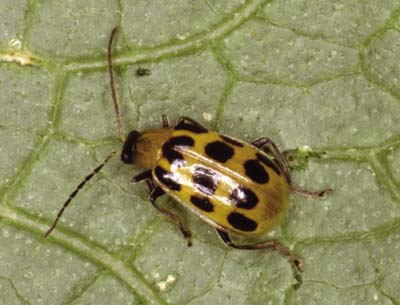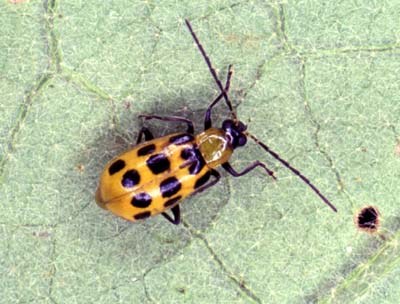Spotted Cucumber Beetle, Diabrotica undecimpunctata
(Coleoptera: Chrysomelidae)
The spotted cucumber beetle is found throughout the United States and is also known as the southern corn rootworm. Environmental conditions, particularly soil moisture, directly affect populations of the spotted cucumber beetle. Four to six weeks are required for the life cycle to be completed and the number of generations per year is variable. The beetle overwinters as an adult in plant debris or in other protected locations. Eggs are yellow and round. The larvae are yellowish-white and mature larvae construct a small chamber in the soil where pupation occurs. The pupae are initially white but turn yellow with age. The adult is yellowish-green with 12 black spots on the wing covers and has a black head.
The spotted cucumber beetle feeds upon more than 200 species of plants. Preferred host plants include cucurbits, legumes, fruit crops, and tomato. Both adults and larvae cause damage. Adults eat small holes in the leaves and flower petals of many plants. Vegetable crops are usually preferred over other agronomic crops. Adults are also capable of transmitting viruses and bacterial pathogens. Larvae feed on the roots of plants and bore into the base of stems. Also, the larvae may feed upon fruit that is in direct contact with the soil, and such larvae are often referred to as "rindworms." Insecticides are often used in order to manage populations of the spotted cucumber beetle. Granular insecticides may be applied in a band over the row to protect roots from damage by larvae. Foliar insecticides may also be applied, but pollinators should be taken into account before applications are made. Cultural practices that are commonly used include altered planting date, clean cultivation, cover crops, trap crops, and host plant resistance. Steinernema nematodes may be used to manage populations of the spotted cucumber beetle but their use is not perfected.
Images
To save the Web-optimized images shown below to your hard drive:
PC users: right click to "Save Picture (or Image) As..."
Mac users: click and drag to your desktop.
Copyright © 2005 University of Florida

